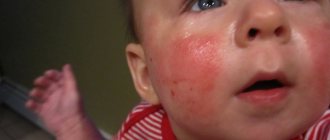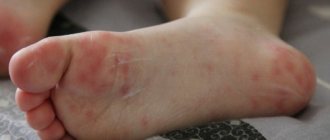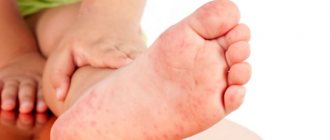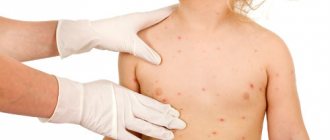From insect bites
One of the causes of redness of the skin is insect bites, and the greatest peak of such foreign interventions occurs during the hot season. Blood suckers (ticks, mosquitoes) inject a substance under the skin that prevents blood clotting. The body reacts to this with redness of the skin and itching sensations. In such cases, you should use drugs whose action is aimed at disinfecting, calming and relieving the inflammatory process. In addition, modern means are focused on preventing the development of an allergic reaction: they prevent an increase in swelling and relieve the feeling of itching.
Such preparations are available in various forms: gels, balms, aerosols, patches, pencils. Creams are considered the most effective. Thanks to the fatty component in their composition, they ensure rapid penetration of medicinal components inside.
Of the drugs presented on the consumer market against insect bites, the following work most effectively: Levomekol, Menovazin, Hydrocortisone ointment, Soventol, Fenistil, Advantan, Akriderm. Traditional recipes recommend applying half a raw potato (cut side) or a cabbage leaf to the affected area.
Bruises
Redness of the skin on the legs may be a consequence of a bruise, which causes swelling of the soft tissues and the possible development of a hematoma. Often a bruise is accompanied by swelling and cyanosis of the skin, painful sensations, and sometimes dysfunction of the joints. It is recommended to relieve swelling and redness through warming physiotherapy, electrophoresis and magnetic therapy. Among the folk remedies, swelling can be reduced with a decoction of calendula and wormwood in the form of warm lotions.
In difficult cases (if the integrity of a large vessel is violated, the inability to move the leg, lameness), the use of antibiotics is recommended, after mandatory consultation with a doctor. If your legs hurt, which doctor should you see? In this case, the help of specialists such as a dermatologist, therapist and surgeon will be relevant.
Allergic dermatitis
Itching and redness on the legs can often be caused by the appearance of pale pink spots, blisters and scaly red rashes. Moreover, the affected area is characterized by clear edges. Most often, dermatitis affects the most delicate areas of the legs - the inner thighs and knees. If not treated in a timely manner, inflammation can spread over a large area.
The most common cause of such allergies is hypersensitivity to chromates, salts that are a common component of shoe leather. Allergic dermatitis is also a reaction to antibiotics, food allergens, household chemicals, washing powder, synthetic clothing and improperly selected shoes. If your legs hurt, which doctor should you see?
Specialists in the field are dermatologist and allergist. Therapy for allergic dermatitis primarily involves avoiding contact with the allergen and administering drug therapy with antihistamines and antifungals. Positive dynamics will be observed in relieving acute symptoms of the disease, reducing the intensity of itching, reducing skin inflammation, and slowing down the process of cell division. In case of complications, antibiotics may be used.
The main causes of rash on the legs in children under 1 year of age
Rash in infants is of particular concern to parents. Babies may become fussy and have difficulty sleeping and eating. They are unable to explain what is bothering them. The most common causes of rashes on the legs and bottom in children under one year of age are allergic reactions due to the introduction of new foods into the diet and diaper dermatitis:
- If their appearance was preceded by the nursing mother consuming a new product, then the formations on the skin are a consequence of the baby’s reaction to this food. It is necessary to introduce complementary foods to babies with caution. Some foods can cause a skin reaction even days after eating them.
- Allergic reactions in infants can also be caused by household chemicals (for example, washing powder, cream) and pet hair. They are expressed by redness and pimples on the butt and thighs (we recommend reading: how to treat acne on the butt in a 5-year-old child?).
- The use of medications is another cause of allergies. Redness appears on the body a short time after the medicine penetrates the baby’s body.
- Diaper dermatitis in newborns is caused by improper child hygiene or overheating (for more details, see the article: diaper dermatitis: symptoms with photos). The rashes merge into a large red spot in the area of the buttocks and thighs. To eliminate the reaction, it is enough to take air baths and bathe the baby in herbal decoctions.
- Dermatitis in the form of scaly and red patches may be atopic in nature. Its treatment involves the use of herbal baths and medications.
READ ALSO: Fatty deposits on the labia: photos, how to get rid of and remove, 3 ways to remove lipoma, causes of appearance
Atopic dermatitis on the feet of a baby
- Small pimples with watery contents in the folds of the legs are signs of heat rash in a baby. This rash is caused by high temperature conditions, high humidity, lack of hygiene, and the presence of warm clothing on the baby’s body. Eliminating the cause of the disease allows you to get rid of prickly heat. You can make your child feel better with the help of powders and creams.
- During the first months of life, most newborn babies develop small white pimples called milia on their bodies. They are natural in nature, as they are caused by the physiological imperfection of the sebaceous ducts of the newborn. The fatty spots usually go away after two to three months; you cannot remove them yourself.
- Melanosis in the form of white spots on the body is a very rare occurrence for newborn babies. It usually goes away within three weeks after it occurs.
Sometimes the causes of rashes in children aged 0 to 1 year are infectious. The appearance of the following symptoms may indicate to parents that there are serious problems in the baby’s body:
- acne spreads throughout the body;
- there is an increase in temperature;
- there is an increase in lymph nodes;
- the baby becomes lethargic;
- There may be vomiting and diarrhea.
Infectious rash all over the baby's body
Psoriasis
Psoriasis on the legs is a chronic form of redness on the leg, severe itching, and the appearance of single inflamed papules, which over time transform into psoriatic plaques with silver-white scales that are easily removed by scraping.
The disease is characterized by an undulating course: acute phases are replaced by periods of remission. are:
- lipid metabolism disorder;
- disruptions in the hormonal system;
- mechanical skin damage;
- stressful situations;
- transferred viral diseases.
Psoriasis can only be treated in a comprehensive way, which consists of using:
- hormonal ointments that stop the development of the disease;
- physiotherapeutic procedures;
- photochemotherapy;
- alternative methods;
- special diet;
- following certain rules for caring for the skin of your feet.
Herpes on the leg
Redness on the leg may be a sign of herpes, which indicates the presence of shingles in the body.
This disease develops along the branches of individual nerves and is accompanied by unpleasant sensations, a feeling of numbness, pain along the affected nerve, redness on the skin and swelling. Then the formation of vesicular eruptions with transparent contents occurs, becoming cloudy after a few hours. The bubbles are located in groups and closely adjacent to each other, often merging with each other, forming larger forms. They subsequently burst, causing the affected skin to become wet. This is very dangerous for the feet, as it can be complicated by fungal and bacterial infections.
Treatment is carried out with systemic antiviral drugs: Valacyclovir, Famciclovir, Acyclovir. The doctor also prescribes immunomodulators (most often Viferon in suppositories), inducers of endogenous interferons (Cyclofen, Amiksin). It is recommended to lubricate the externally affected areas with an alcohol solution of brilliant green, which causes the elements of the rash to dry out and quickly form crusts on them. Antiviral ointments and creams containing acyclovir must be applied externally. To avoid complications, herpes on the leg is treated only under the supervision of a doctor.
Eczema
Redness on the leg may indicate the presence of eczema, a chronic disease that has a neuro-allergic nature and affects both men and women with equal frequency.
Symptoms of eczema:
- the appearance of blisters, nodules, scales, crusts, erosions on the skin;
- severe redness of the skin of the legs due to dilated capillaries;
- itching sensation;
- dryness and flaking of the skin;
- disturbance of wakefulness and sleep.
Causes of eczema:
- genetic predisposition;
- disruption of the thyroid gland, adrenal glands, endocrine and central nervous systems;
- skin diseases;
- injuries;
- professional factors depending on the harmfulness of work. Workers in the metallurgical, printing, and pharmaceutical industries are at high risk;
- external factors: hypothermia, overheating,
Treatment of the disease is complex and consists of taking sedatives (Nozepam, Chlozepid, Novopassit, Persen), enterosorbents (Multisorb, Enterosgel, Polysorb, Polyphepan), hormonal ointments (“Oxycort”, “Cloveit”, “Diprogent”, “Betazon”), antihistamines (“Diphenhydramine”, “Promethazine”, “Chloropyramine”).
Redness on the legs, the causes of which have very different explanations, should definitely attract attention, as they can be serious and indicate inflammatory processes occurring in the body.
Complications of diabetes mellitus often manifest as vascular and neurological disorders that affect the lower extremities. Therefore, it is recommended that all diabetic patients examine their feet and legs daily so as not to miss the initial manifestations of diabetic neuropathy.
Any symptoms in the form of redness, loss of sensitivity or minor injuries may be a signal of the development of a serious disease such as diabetic foot.
According to statistics, it occurs in 15% of diabetics after 5-6 years of illness.
If diabetes is poorly compensated, a purulent infection joins the polyneuropathy, and gangrene may also develop, necessitating amputation.
Globally, 70% of amputations performed are related to diabetic neuropathy.
Why and why
A rash is a symptom of a disease or condition that can be caused by:
- allergens;
- parasites;
- infections (bacteria, viruses);
- failure to comply with personal hygiene rules;
- disturbances in the functioning of the nervous system.
Allergic manifestations
The body can react with the appearance of various types of pimples upon contact with plants, household chemicals, cosmetics, animal hair, fabrics, low-quality toys, or when consuming any foods, drinks, or medications.
Allergies can be chronic or acute. In the first case, the rashes are characterized by seasonality—in summer there is complete or partial remission, in winter there are relapses. In the second case, the reaction occurs suddenly and is not associated with any periodicity. However, the acute course can be dangerous - there is a risk of developing Quincke's edema.
A sudden rash on the arms and legs of a child of any age causes panic in almost all parents. It is not surprising - often such reactions are accompanied by itching, which irritates the baby and does not allow him to eat, sleep, or play peacefully.
In order not to guess what it could be, but to quickly provide help, you need to understand the types of blisters and their causes. Our article will help with this.
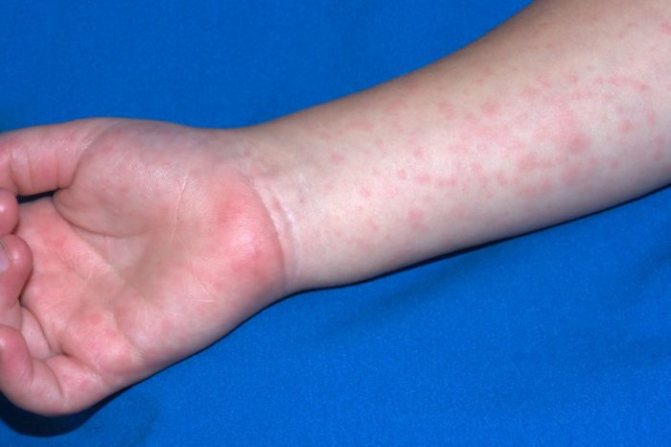
Demodecosis manifests itself when a person’s immunity is weakened, because the mite that causes the disease lives constantly on the body. In children, the parasite can be activated after an infectious disease. The skin on the face is primarily affected - around the eyes, mouth, nose. The bumps turn red, peel, and itch very much.
Allergy on the legs of a child is a painful condition that occurs as a result of exposure to an allergen and is characterized by the formation of a rash on the lower leg, foot and toes. It is more often observed in children of primary preschool age and infants, which is due to an insufficiently developed immune system. The rash is a symptom of the disease. It is important to determine what produces the reaction.
We recommend reading: Cold urticaria - how to properly treat it in children and adults
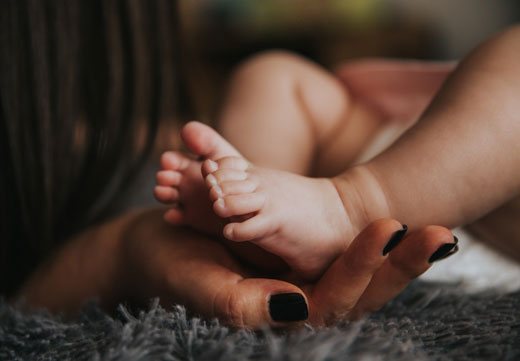
Causes of neuropathy in diabetes
Damage to the blood vessels of the legs in diabetes mellitus is associated with excess glucose in the blood, which cannot enter the cells due to insulin deficiency. Blood flow through the vessels decreases, the conduction of nerve impulses is inhibited. In conditions of weak innervation and reduced nutrition, tissue sensitivity suffers and wound healing slows down.
Minor skin lesions in the form of cracks, cuts or abrasions turn into open ulcerative defects, and hidden ulcers form under the layer of keratinized epithelium. All this may not be noticed by patients, since it does not cause discomfort with low sensitivity. Most often, ulcers form in areas of increased stress that occurs when walking.
Such damage can be aggravated by wearing tight shoes, increased dry skin and thickening of the stratum corneum, and injury during a pedicure or walking barefoot.
Blockage of a blood vessel is associated with the deposition of cholesterol and calcium, forming an atherosclerotic plaque. Such changes in diabetes mellitus have several clinical features:
- The lesion occurs in the lower parts of the lower extremities - in the foot and lower leg.
- Both legs suffer and in several areas.
- Onset at an earlier age than in patients without diabetes.
- Accompanied by tissue death
- Ulcers can occur without trauma or mechanical stress.
Signs of leg damage in diabetes mellitus
Sugar level
The skin of patients with diabetes is dry and thin; they are often injured, especially in the area of the fingers. The trigger for the development of neurological and vascular lesions can be fungal infections, rough pedicures, or surgical removal of an ingrown toenail.
Since the formation of a diabetic foot has very serious consequences in the form of amputation of the leg or death from sepsis, which developed as a result of a purulent complication, identifying the first signs of diabetic foot damage can save the patient’s life.
The very first sign is a decrease in vibration sensitivity, then temperature, pain and tactile sensitivity are disturbed later. An alarming symptom may be swelling in the leg below the calf, in the foot area. If your feet become hot or cold, this means that blood circulation is impaired or an infection has developed.
The following changes may be the reason to contact a surgeon or podiatrist:
- Increased fatigue when walking.
- Pain in the legs of varying intensity occurs when walking or at night.
- There was tingling and burning in the feet, and increased chilliness.
- The skin color on the legs is red or bluish.
- The hair on the legs has decreased.
- The nails became thickened, deformed, and yellowed.
- There was a bruise under the nail plate.
- The finger suddenly turns red or becomes swollen.
Patients may also notice that wounds or calluses heal within a month or two instead of a week. After the wounds heal, a dark mark remains.
Ulcers may appear on the feet, sometimes quite deep.
Types of diabetic foot
Depending on the prevalence of innervation or blood supply disturbances, three forms of diabetic foot syndrome are distinguished. With a lack of conductivity in nerve cells, a neuropathic form develops. Its characteristic feature is the easy detection of arterial pulsation. Severe and persistent swelling appears on the legs.
Feet with this form are warm, the skin color is normal or slightly pale, the ulcer is located (as in the photo) in an area of increased stress - in the area of the metatarsal bones. The pain syndrome is mild. The wound is moist, the edges are thickened. It most often affects young people with type 1 diabetes, and alcohol abuse may be a predisposing factor.
Redness of the leg with diabetes mellitus in the photo may be a sign of an ischemic form of polyneuropathy, in which disturbances in the blood supply determine the symptoms of the diabetic foot.
With this option, the legs are cold, the pulse is difficult to determine, and the feet may take on a bluish tint.
The ulcer is located in the areas of poorest blood supply - the heels, the outer edge of the foot, and the big toe. The skin around the wound is thin. In this case, patients are bothered by pain at rest, which intensifies at night; when walking, they are often forced to stop due to severe pain.
The mixed form is most often diagnosed in patients with diabetes; it combines symptoms of ischemia and neurological disorders. Risk factors for developing diabetic foot are:
- Duration of diabetes more than 10 years.
- Decompensated or labile diabetes mellitus.
- Smoking.
- Patients who have had a heart attack or stroke.
- Alcohol abuse.
- With a tendency to form blood clots.
- Severe obesity.
- Varicose veins.
Diagnosis and treatment of neuropathy in diabetes
To diagnose the extent of damage, patients undergo a full examination: blood tests for glucose and biochemical analysis, determination of kidney function, X-ray and angiographic studies. A neurologist checks the integrity of reflexes and sensitivity to pain, touch, vibration and temperature.
To determine blood flow, Doppler measurements are performed and pressure in the vessels of the legs is measured. If an ulcer is present, a culture is taken to test the microflora and sensitivity to antibacterial drugs.
Treatment for diabetic foot begins with bringing blood glucose levels to target levels. If the patient received tablets to lower sugar, then he is completely transferred to insulin or the administration of long-acting insulin and antidiabetic drugs in tablets are combined.
Relief of pain in diabetic polyneuropathy is carried out with the following drugs:
- Anticonvulsants (Finlepsin, Gabalept).
- Painkillers (Dexalgin, Nimesulide).
- Antidepressants (Venlafaxine, Clofranil).
- Lidocaine cream.
Treatment with thioctic acid preparations (Tiogamma, Berlition), as well as injections of B vitamins (Milgamma, Neurobion) helps restore tissue sensitivity and accelerate the healing of the ulcer. To improve blood circulation, the drugs Dipyridamole, Actovegin, Pentoxifylline are used.
In addition, ulcers are treated and the affected limb is unloaded. If you have ulcers on the shins, you should try to be in a horizontal position more often. Special orthopedic devices are also used to relieve stress on the foot. In the fight against this disease, complex treatment gives positive results.
If an infection occurs, antibiotic treatment is prescribed for a long period until the ulcer heals.
Intensive therapy is also carried out to treat concomitant diseases that complicate the recovery of patients: anemia, kidney damage, liver damage.
How to identify an allergen
If a child or adult has an allergy on their leg, the following methods for diagnosing the disease are used:
- blood test for immunoglobulins;
- allergy tests (for children over 5 years old), which involve the introduction of a provoking factor through the skin.
If it is impossible to determine a harmful factor, the doctor conducts an examination by exclusion. To do this, the body is affected by provoking factors, gradually eliminating their likelihood. The work is recorded in a special diary.
Prevention of polyneuropathy
For a patient with diabetes, examining the feet during daily hygiene procedures is an important method of preventing complications of neuropathy. All wounds or cuts should be treated with Miramistin or Chlorhexidine, an aqueous solution of furatsilin. Do not use solutions containing alcohol.
Solcoseryl, Actovegin, and Iruksol gels are used to treat ulcers. When performing a pedicure, you cannot use blades; it is better to use hardware techniques. Feet should be lubricated with baby cream to prevent dryness or with special ointments for diabetics: Balzamed, Alpresan.
When putting on shoes, you need to inspect them for the integrity of the insoles, the absence of stones, hard folds or scars that can injure the skin of the foot. Shoes must be selected exactly in size and instep height. In this case, you should not use narrow socks that squeeze your toes. For home wear, choose slippers with a closed heel and toe.
- Complete cessation of smoking and alcohol.
- Avoid overcooling your feet.
- When performing foot baths, their temperature should be about 36 degrees.
- If you have poor vision, you cannot cut your nails yourself.
- It is not recommended to walk barefoot even at home.
- Do not use heating pads, batteries or air heaters to warm your feet.
The main method of preventing all complications of diabetes is to control blood sugar levels. To do this, you need to use it daily and also determine the level of glycated hemoglobin once every three months and visit an endocrinologist to correct the treatment. At least once a year, consultation with a pediatrician and neurologist is recommended.
Itching, burning, rashes, redness on the legs or one leg can be caused by many factors that are caused by a malfunction in the body or external influences. The skin reflects the human condition, the functioning of internal organs and systems. Often, skin symptoms indicate the development of a serious disease - varicose veins, diabetes mellitus, thrombophlebitis.
Folk remedies

Rash on the body As an additional treatment for an allergic rash on the legs of a child, you can use folk remedies. You can prepare such medicines yourself at home. Let's look at some of the most effective recipes that have received only positive reviews.
- You will need fresh tops of young carrots (9-10 branches). Pour boiling water over it and let it brew for 3-4 hours. Use this decoction as a medicinal lotion. Wet the cotton wool and wipe the affected areas of the epidermis. In addition, you should drink 50 ml of carrot water 3 times a day.
- Add an infusion of bay leaves to the bath while bathing the child, and then apply zinc ointment to the dried skin using circular massage movements.
- Lubricate stains with sea buckthorn oil.
- Bathe your child in a decoction of wormwood.
Folk remedies are absolutely safe for the health of the child. However, before using them, be sure to consult your doctor to make sure that your baby does not have a negative reaction to the active components of the product you prepared yourself.
Redness of the legs above or below the knees: mechanical causes
Hyperemia of the skin on the legs is caused by:
- Clothing material that irritates the skin. For example, pants made of rigid fabric or tights containing fibers that prevent air penetration;
- Uncomfortable shoes cause painful redness on the feet. Calluses and corns form. In this case, pain syndrome is observed;
- Depilation is characterized by a high probability of injury to the integrity of the skin, which leads to skin itching and itching;
- Insect bite. The bite itself leads to the development of itching. When scratching, a person injures the skin, and a bacterial infection cannot be ruled out.
To get rid of an unpleasant symptom, it is enough to pay attention to these causes and neutralize them. If the problem is uncomfortable shoes or poor-quality clothing, then the itching and hyperemia disappear.
Symptoms of diaper rash between the toes
The disease begins with mild redness and pimples that resemble prickly heat. Red spots affect the skin on the feet and between the toes.
Due to constant humidity, irritation progresses here, which contributes to the development of other symptoms:
- the skin on the feet peels off;
- ulcerative skin lesions occur that constantly itch and may bleed;
- a persistent unpleasant odor emanates from the lower extremities;
- inflammation of the injured areas begins.
Diaper rash causes small sores to appear between the toes.
Sores on the affected feet can cause pain and burning. In advanced cases, suppuration occurs as a result of the addition of a concomitant infection.
Diseases that lead to redness of the legs
If irritation appears on the lower extremities, there is itching, burning and other alarming symptoms, then this may indicate eczema, dermatitis, an allergic reaction, scabies, erysipelas, diabetes mellitus, autoimmune pathology and other diseases. Why the spots appeared on the legs, the patient can only guess. A doctor will help determine the true cause after laboratory tests and diagnostics.
Important: the likelihood of a positive result with self-treatment is low, and the risk of complications is high.
Erysipelas
Infectious pathology is characterized by inflammatory processes in the skin, the causative agent is group A streptococcus; if the appearance of redness is observed in autumn or summer, then it may be erysipelas.
The pathology most often occurs in men who work in conditions that lead to contamination and cooling of the skin - loaders, military personnel, miners, etc. The pathogen enters the body through wounds and scratches. But it does not always provoke a pathological condition.
Causes of redness of legs:
- Chronic pathologies of the skin (for example, psoriasis, neurodermatitis).
- Skin diseases of a viral nature (shingles, herpes).
- Low immune status.
- Impaired blood circulation in the body.
- Fungal skin lesions.
The disease is characterized not only by redness of the extremities, but also by signs of general intoxication of the body - weakness, pain in the muscles, attacks of nausea, drowsiness, loss of appetite. In most cases, erysipelas manifests itself in the lower leg area. Complications include the formation of ulcers and gangrene.
Mycosis of the feet
Mycosis is a group of pathologies that develop as a result of the negative effects of pathogenic fungi. The causative agent is a filamentous fungus. Infection occurs with a sick person or through interaction with objects contaminated with fungi.
Clinical manifestations:
- First, the feet peel;
- There is slight itching;
- A rash appears between the toes and on the sides of the foot (rare);
- Bubbles filled with watery contents form.
In old age, against the background of a weak immune system, the clinical picture is often complicated by the addition of a bacterial infection.
Herpes on legs
The appearance of a red spot may indicate a herpes infection. The pathology is provoked by the third type of herpes virus. Infection occurs from a sick person who is the source of the virus. However, contact with a sick person is not a 100% chance of herpetic lesions on the legs.
The virus is activated under the influence of harmful factors:
- Frequent respiratory pathologies.
- Neuroses, stress.
- Taking medications that reduce immunity.
- Chronic fatigue.
After the virus penetrates, a slight swelling is observed on the reddened leg (as in the photo). The patient suffers from itching and burning. Additionally, symptoms include weakness, general malaise, and may have a fever.
After a short time, the affected area becomes covered with a small rash with cloudy contents. The bubbles are located in small groups. They tend to merge into massive conglomerates. When the blisters burst, weeping ulcers appear.
For your information, if there is dryness in the mouth, aches throughout the body, it means that the body has been intoxicated with waste products, and the virus multiplies rapidly.
How to distinguish foot allergies in a child from other diseases
Dermatitis
Allergy on the legs of a child is a painful condition that occurs as a result of exposure to an allergen and is characterized by the formation of a rash on the lower leg, foot and toes. It is more often observed in children of primary preschool age and infants, which is due to an insufficiently developed immune system. The rash is a symptom of the disease. It is important to determine what produces the reaction.
Causes and symptoms of allergies in children
There are endogenous (internal) and exogenous (external) factors of the disease. Endogenous causes include hereditary predisposition and diseases of internal organs. Exogenous factors involve the influence of a factor from the external environment.
The most common allergens:
- food products, which is especially important for babies fed on breast milk. A rash on a child's legs indicates deficiencies in the mother's nutrition;
- Pets;
- things made of wool and down;
- dust;
- clothes and shoes made of low-quality materials;
- household chemicals and cosmetics;
- stressful situations (scientists have proven the relationship between allergies and psychosomatics);
- exposure to cold;
- medications;
- flowering plants;
- insect bites.
Symptoms of an allergic rash are: itching, swelling, redness, dry skin. The affected area begins to itch very much. Manifestations depend on the type of rash: with urticaria, pink spots are formed that can be localized anywhere.
Signs of a dangerous manifestation of an allergy - anaphylactic shock - are: loss of consciousness, shortness of breath, vomiting, involuntary urination and defecation.
What diseases might a red rash on the legs look like?
The appearance of a rash on a child’s skin should alert you. You should not put off going to the doctor. Only a doctor is able to diagnose and prescribe the necessary treatment.
There are diseases in which the rash is similar to an allergic one.
- Dermatitis is a skin disease characterized by rash and severe itching, peeling, blistering and pimples. With dermatitis, the body’s reaction occurs immediately; with allergies, it may take more than 1 day. For both diseases, identification of the cause is required, for which special dietary nutrition is prescribed.
- Fungal infection of the skin is accompanied by redness and then peeling. Allergies are characterized by a typical red rash.
- Miliaria appears as small pink spots. The main difference is the lack of tendency of the rash to inflammation. Miliaria can be identified by its location - most often in the area of the baby's folds.
- Scabies is characterized by the formation of large red spots over the entire surface of the body. The rash causes discomfort and is accompanied by itching. With allergies, itching occurs more often during the day, and with scabies - at night. Scabies is a contagious disease.
- Measles is accompanied by a rash with fever, cough, and fever. The rash appears after 3-4 days, it is similar in both cases. A distinctive feature of allergies is the absence of the above symptoms.
- Chickenpox in the first day leads to the formation of a red rash that looks like an allergic one. Subsequently, blisters form at the site of redness. Another feature: if chickenpox is not treated, it will go away on its own; in case of allergies, the rash will only go away if the cause that caused it stops working.
The best way to differentiate an allergic rash from another is to take antihistamines. With this disease, the rash will go away; for the other diseases listed above, the medicine will not work.
How to get rid of a child
In order for a child’s foot allergy to go away, it is necessary to determine the temperature that caused the body’s reaction.
To eliminate the symptom, you should take antihistamine tablets and ointments as prescribed by your doctor: Suprastin, Zodak, Telfast, Fenistil, Allergodil (sold at the pharmacy).
Safe drugs are third generation drugs: Telfast and Zodak. They do not cause drowsiness or heart rhythm disturbances.
In emergency cases, the doctor prescribes hormonal drugs - Advantan, Elokom.
Medications can only relieve painful symptoms. Stopping exposure to the provoking factor can completely cure the rash.
The use of traditional methods is aimed at eliminating pain. The following recipes will help relieve pain from a rash on the foot.
- In 1 liter of boiling water, brew 1 tablespoon of chamomile, string, calendula, nettle or oak bark herbs. Use for preparing compresses. Baths made from herbal solutions will have a positive effect. The listed decoctions will not harm even infants.
- Prepare an ointment from birch tar and petroleum jelly mixed in a 1:1 ratio.
How to identify an allergen
If a child or adult has an allergy on their leg, the following methods for diagnosing the disease are used:
- blood test for immunoglobulins;
- allergy tests (for children over 5 years old), which involve the introduction of a provoking factor through the skin.
If it is impossible to determine a harmful factor, the doctor conducts an examination by exclusion. To do this, the body is affected by provoking factors, gradually eliminating their likelihood. The work is recorded in a special diary.
Allergic reaction: redness, itching, swelling
Redness on the legs may be an allergic reaction. It occurs for a number of reasons, resulting in a detrimental effect on the human body. The main reason is the deterioration of the immune system.
Provoking factors are identified:
- Irritation of papillary receptors;
- Penetration of allergens into the body;
- Heredity;
- Increased vascular permeability.
When allergies manifest in the lower extremities, in most cases the etiology is based on increased permeability of blood vessels. The vascular walls become weak, as a result of which some components of the biological fluid penetrate into the cell space.
The longer the contact with the pathogen - the allergen - lasts, the stronger and more intense the disease of an allergic nature manifests itself. In the absence of timely treatment, the pathology progresses. Redness can be localized in other parts of the body - spots appear on the chin, arms or all over the body.
Symptoms of an allergic reaction:
- Spots and rashes on legs.
- Feet peel and hurt.
- Severe itching.
- Burning (sometimes).
- The phalanges of the fingers are soft and red.
With low body resistance, even a healthy person with no history of allergies may experience clinical manifestations.
Why does itching and burning appear between the fingers?
In medical practice, there are hundreds of reasons why itching occurs between the fingers of the lower extremities. Let's consider common pathologies that lead to such an uncomfortable symptom.
Eczema
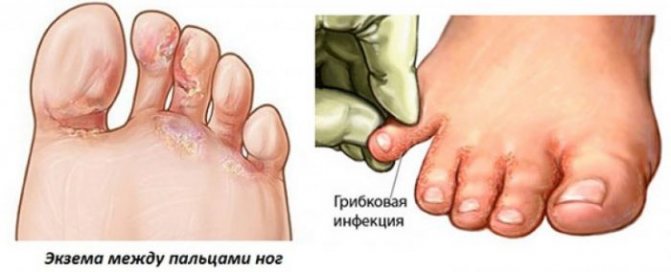
Why it itches between the toes, the doctor’s answer is after a thorough diagnosis and collection of the patient’s medical history. However, this clinical manifestation suggests that eczema has developed. This is a chronic skin disease that is prone to frequent relapses.
In medicine, chronic pathology is divided into types: true, professional and microbial type. The only reason for the true form of the disease is genetic predisposition.
Occupational eczema is based on an allergic reaction to any components or substances upon close contact with them. The development of the microbial form is based on infectious diseases of the skin.
Depending on the clinic, eczema can be:
- Wet form. Against the background of this pathological condition, there is not only itching between the fingers, but also hyperemia and swelling. Quite quickly, the symptoms are complemented by the formation of bubbles, which are filled with colorless exudate or blood content. The blisters burst, leaving behind erosive damage with drops of liquid on the surface. When the severity of the inflammatory process decreases, the number of blisters decreases, crusts and scales appear.
- Dry eczema is accompanied by a high degree of dryness of the skin, it constantly flakes and itches. Over time, the skin becomes compacted and thick, a pattern appears between the phalanges of the fingers and on the pads thereof. If you do not seek help from a medical facility in time, the skin color becomes bluish.
Treating eczema is a very long and difficult process. Severe itching between the toes will disappear only when stable remission of the disease can be achieved. Therapy can take an inordinately long time.
Scabies as a cause of itching
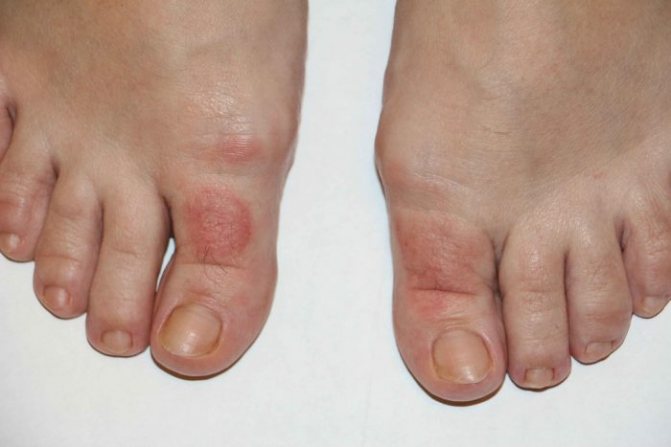
Between the toes with scabies itches due to the body's immune response to the waste products of the pathogenic parasite - the scabies mite. Its favorite habitat is thin and delicate skin, and between the toes favorable conditions are created for its parasitism.
The itchy sensation is long-lasting and exhausting, causing a lot of inconvenience and discomfort. The symptom tends to worsen at night. When scratched, the skin becomes rough, peels and becomes covered with tiny cracks, which increases the likelihood of secondary infection.
Fungal infection

A fungal infection is often accompanied by interdigital itching. The ideal environment for parasitism is a decrease in immune status and increased moisture in the skin (sweating feet).
Important addition: Reviews of castor oil for warts
The course of the pathology is characterized by itching and irritation between the toes. There are two currents: with and without weeping. In the first option, flat bubbles with liquid contents appear, they burst, leading to long-term non-healing erosions. In the dry form of the fungus, the patient is bothered by itching, burning, swelling and redness of the skin.
Diabetes mellitus as a cause of redness on the legs
Diabetes mellitus is a chronic disease due to which patients experience constantly high blood sugar. Chronically high glucose provokes many complications. One of them is the appearance of red spots on the legs. Hyperemia is caused by damage to the structure of blood vessels, which have become thinner due to high sugar in the body. Hyperemia occurs on the foot and lower leg; in most cases, both legs “suffer” at the same time.
If redness is caused by diabetes, other symptoms will be present:
- Fatigue during physical activity;
- Pain syndrome in the legs of varying intensity;
- Hair loss on legs;
- Bruising under the nail plate;
- Changes in the structure of nails: thickening, deformation;
- Swelling.
Important: “harmless” redness in the absence of timely treatment can transform into open ulcers with subsequent tissue necrosis.
The causes of redness on the legs of women and men are many and varied. They are associated not only with mechanical stress - poor quality clothing, but also with serious systemic diseases. Ignoring or self-medicating means a high risk of complications.
Red spots on the soles of the feet and small spots on the legs below the knees can be the cause of various diseases. Some of them require immediate medical attention, others are chronic and do not cause unpleasant accompanying symptoms. Additional signs that the article will tell you about will help you recognize the disease.
Allergies on a child’s legs: how to cure rashes and red spots on the skin
string(10) “error stat”string(10) “error stat”string(10) “error stat”
Quite often, children experience all sorts of allergic reactions, affecting their hands, face, buttocks, and other areas of the skin. It should be noted that allergies in a child’s legs bring especially a lot of anxiety to parents and discomfort to the little patient.
General information about the disease
Increasingly, young children are developing allergies in their legs, depriving them of their usual mobility and causing discomfort.
Children's immune system is not yet formed and is not able to adequately respond to all kinds of irritants. Even the most seemingly harmless substances can cause an aggressive reaction in a child’s body.
Often, rashes on a child’s legs appear within the first hours after the allergen enters the body. To detect the disease at the very beginning, parents should closely monitor the child’s health, examining his skin daily.
It should be remembered that almost invisible blisters on the legs can lead to serious consequences for a small patient.
If rashes appear on your legs, you should visit a medical facility as soon as possible. The specialist will carry out a series of diagnostic measures and, having thus found out the cause that provoked the allergic reaction, will prescribe suitable therapy.
Any kind of rash is a sign that the baby’s body is malfunctioning for some reason. Before prescribing treatment, doctors determine the cause of the allergy.
Reasons for appearance
There are many known adverse factors that cause rashes on children's legs.
The main ones:
- Wearing poor quality shoes. However, it happens that the most expensive leather sandals or woolen socks cause itching and redness of the feet and toes.
- Insect bites in the warm season, when children are wearing open sandals. Midges, mosquitoes, spiders and other insects.
- Animal waste products are themselves allergens.
- Synthetic tights, socks and other items of clothing can provoke severe allergies, especially on the bends of the legs.
- Plant pollen.
- Exposure to heat or cold. For example: after bathing in too hot water, a rash appears between the child’s legs. And prickly heat occupies the folds of the lower extremities, manifesting itself as redness.
- Food products: eggs, fish, red berries, chocolate and cocoa very often cause diathesis on the legs of a child, beets, nuts, citrus fruits, honey.
- Dust and dust mites living in the atmosphere of a children's room.
- Fungal diseases.
- Use of phosphate household chemicals. Red itchy spots form on the butt and legs.
- Medications.
- Genetic predisposition.
- Stress.
- Predisposition to colds.
- Low immunity.
- Poor diet during breastfeeding.
- Unsuitable formula for feeding infants.
- A red rash on the legs appears in babies suffering from infectious diseases.
- Diaper rash.
- Dermatoses.
- After using low-quality diapers or hygiene products from dubious manufacturers, red spots form on the child’s legs and bottom. If the diaper is not changed in a timely manner, the baby will develop diaper rash between the legs.
Having noticed flaky red spots on their child’s legs, most parents consider two options: an allergic reaction or lichen. Few people know that such signs usually occur in children with a genetic predisposition.
Forms, types, stages, signs
Primary signs of allergies include:
- rough skin;
- redness;
- dry skin of the feet.
Rashes are divided into several types:
- spots of pale pink or red color that appear on a certain area of the leg or are distributed over its entire surface;
- cold, hives on the child’s legs or prickly heat lead to the formation of large blisters with peeling and severe itching;
- barely noticeable redness consists of itchy, scaly spots;
- pimples on a child's legs look like small red dots with pus underneath. Over time and without proper treatment, acne becomes covered with a dry crust;
- swelling.
If we are talking about hives, the skin on the legs becomes covered with bright pink blisters. The rashes quickly occupy the soles of the feet and, like any allergic rash on the feet, are accompanied by severe itching. The advanced form threatens life-threatening complications for the baby.
Children under 3 years of age sometimes develop atopic dermatitis on the legs. On the reddened, inflamed skin, blisters form, which, when opened, transform into weeping erosions.
Most often, signs of allergy appear on the feet or on the bend under the knee.
If you discover a rash on your child’s legs, you should immediately contact your pediatrician to protect your child from developing severe complications.
Symptoms
The symptoms of this pathological condition directly depend on the root cause, and therefore the type of allergy.
If the baby has become restless, is capricious and constantly cries, it is necessary to examine his skin. Allergic rashes involve severe itching and the child is not able to cope with it on his own.
In most cases, the pathology manifests itself on the feet, under the knees, in the calves, thighs, and legs.
As a rule, allergic rashes on the legs have the following symptoms:
- itching;
- the skin “burns”;
- bright red spots of all shapes and sizes;
- pimples on legs;
- rash in a child, in the form of blisters, pustules, etc.;
- violation of skin texture;
- roughness, peeling;
- dry skin, cracks;
- swelling of the legs or in the area of the rash.
The first “bell” about a developing allergic reaction is:
- peeling;
- dryness in the extremities;
- redness.
Unnoticed by parents, the allergy progresses, as evidenced by the following manifestations:
- dotted or diffuse spots that rise above the skin have a pale pink or reddish tint. Merging with each other, the spots can cover large areas of the skin, affecting the feet.
- raised reddish pimples of any size and shape. Very often pustules appear on them. With the development of pathology, acne becomes covered with a dry crust.
- swelling occurs due to the accumulation of large volumes of fluid in the subcutaneous tissue. It looks like a swollen, pale lump. Does not cause any distress to the child.
- Itchy blisters are a sure sign of hives or hypothermia. As they grow, they cover large areas of the skin. With the long-term development of the pathology, weeping spots form on the baby’s skin.
Often, an allergic rash on the legs occupies children's feet, manifesting itself in this way:
- bright red skin;
- itching;
- burning;
- dryness;
- bubble formation;
- swelling of the feet.
If an allergic rash has formed in the lower leg area, it manifests itself as redness, peeling, and dry skin.
Between the legs - in the form of red spots.
A rash on the butt and thighs - in the form of small itchy pimples and red, scaly spots.
As the pathology progresses, it can lead to serious complications. Any of the above symptoms is a good reason to visit a specialist. It should be remembered that immediate, competent therapy is the key to a quick recovery.
Treatment
Basic remedies for foot allergies:
- Antihistamines: Zyrtec, Suprastin.
- Hormonal: Prednisolone, Kenalog.
- Immunomodulators are used for children at least 3 years old.
- Corticosteroid ointments that relieve inflammation and unpleasant symptoms.
- Enterosorbents remove the allergen from the body: “Enterosgel”.
To relieve itching, use salt applications and special ointments. Ointments are prescribed exclusively on an individual basis, because have a lot of side effects.
During treatment, contact with the allergen should be avoided.
It is necessary to exclude foods that can cause an allergic reaction from the children's diet.
For bath procedures, use only hypoallergenic products.
Folk recipes
Make a decoction of chamomile, string, calendula and add it to the child’s bathing water (no longer than 20 minutes).
Can be used as compresses: take 1 tbsp. herbs, pour 1 liter of boiling water. Leave for 30 minutes, strain.
Wipe the affected areas with nettle infusion. 1 tbsp. leaves, pour 200 ml of boiling water, leave for 30 minutes.
There are many folk recipes for treating allergies in a child’s feet, but before you start using them, you need to consult your doctor. Only a qualified specialist can choose an effective, safe remedy. Otherwise, you can only harm the little patient.
Prevention
To protect your baby from allergic reactions of the body and rashes on the legs, you should adhere to the following rules:
- Strengthen children's immunity.
- Buy comfortable shoes of the best quality.
- To cure, and not to heal emerging pathologies.
- Eliminate allergenic foods.
- Dress strictly according to the weather.
- Be attentive to the baby's well-being.
- Use care products without fragrances or dyes.
Medicines for bronchial asthma: list of the best and effective drugs
Allergy to gel polish: how to get rid of itching, redness and blisters on your fingers after a manicure
Allergy pills: list and cost of the best and effective drugs
What to do when an allergy appears on your hands in the form of red spots or blisters
15 hypoallergenic dogs for apartments and houses: small, medium and large breeds
Allergic skin itching: how to relieve it at home, ointments, tablets
Allergy in a baby on the face: photo with explanations, what it looks like, treatment
Allergy to medications: photos, symptoms, what to do, treatment
Allergy to the butt in a child: photo, how to treat it, what it looks like
Effective ointments and creams for skin allergies
Allergy to antibiotics: what to do if a skin rash appears
Rash on the buttocks in an adult: photos with explanations of various rashes on the buttocks
Source: //topallergy.ru/zabolevaniya/allergiya/na-nogah-u-rebenka-foto.html
Causes of small red dots and spots on the soles of the feet
red dots appeared on the legs in the photo
Diseases with this symptom can be divided into two groups depending on the age of the patient. Sometimes red spots on the soles of the feet and small dots on the legs below the knees indicate a childhood illness that is not typical for an adult and vice versa. The reasons also need to be differentiated; they will differ for women (men) and children.
The child has
In children, the following pathologies or body conditions can cause unpleasant symptoms:
In an adult
In an adult, the following pathologies often cause the appearance of red spots on the soles of the feet and small spots on the legs below the knees.
Note! Mycosis of the foot is infectious in nature and can be dangerous to others, unlike other pathologies.
Diseases with a rash in the form of red dots
A red rash and itching on the legs are signs of many diseases that affect the skin or internal organs. These ailments often represent complex infectious pathologies, as well as systemic changes leading to disturbances in the properties of the blood. If the red rash on your legs itches, most likely the disease is inflammatory in nature, and therefore requires appropriate therapy.
The rash can appear on the lower extremities in patients of any age. This rash may itch, peel, swell, or spread into healthy areas of the skin. In this case, different parts of the legs are covered with red spots: shins, thighs, soles. All symptoms of the disease are valuable information that the attending physician uses in determining the main diagnosis. Therefore, if red rashes appear in the leg area, it is necessary to tell specialists everything in detail.
Allergic contact dermatitis
This allergic disease develops on healthy skin of the legs as a result of its contact with an irritant. In this case, symptoms such as the appearance of an itchy rash in the form of bubbles with a clear liquid (exudate) of different sizes on the red and swollen skin of the lower extremities come to the fore. Over time, painful erosions form in their place, which, as the inflammatory process subsides, become covered with yellow crusts and regress. The disease is persistent (chronic) in nature and can worsen with repeated contact of the skin with allergens.

Scabies
If the rash on the legs in the form of red dots in an adult is itchy, you should think about infection of the skin with scabies mites. The main symptom of the disease is rashes that look like stripes up to 20 mm long. Small bubbles are visible at one end of this formation. Scabies rash is most often localized in the natural folds of the body, and on the legs it can appear in the thighs and lower legs. A child is often diagnosed with a rash under the knees. The rash is accompanied by intense itching, which intensifies after taking a shower and at night. Therefore, if the rash on the legs in the form of red dots in a child is itchy, it is necessary to immediately show him to the doctor.
Herpetic lesion
As a rule, a herpetic rash on the legs is part of a complex lesion of the skin by the herpes virus involving nerve fibers in the pathological process. As the disease develops, blisters first appear on the covering epithelium, which are accompanied by severe itching. Then the formations burst, and the wound surface is covered with dark-colored crusts, sometimes hemorrhagic.
Hemorrhagic vasculitis (Henoch-Schönlein disease, allergic purpura, capillary toxicosis)
The disease is a complex set of symptoms associated with damage to the vascular wall. Among the causes of the disease are infectious diseases, viral diseases, allergic reactions, general hypothermia, stress, and heredity. Hemorrhagic vasculitis occurs against the background of increased body temperature. First, a hemorrhagic rash appears on the ankles and calves, which then spreads throughout the body. Each such spot is accompanied by swelling; over time, the patient begins to complain of pain in the abdomen and joints associated with hemorrhages in these areas.

Thrombocytopenic purpura
Another disease in which elements of a red rash appear, localized to the thighs and lower legs, is called thrombocytopenic purpura. The disease is a rare pathological condition and can be diagnosed in both children and adults. The disease is associated with premature destruction of platelets, which entails rheological changes in the blood. At the beginning of the development of the pathological condition, patients complain of small red dots on the legs below the knees, which over time turn into ecchymoses of significant size (large hemorrhages into the skin or mucous membrane).
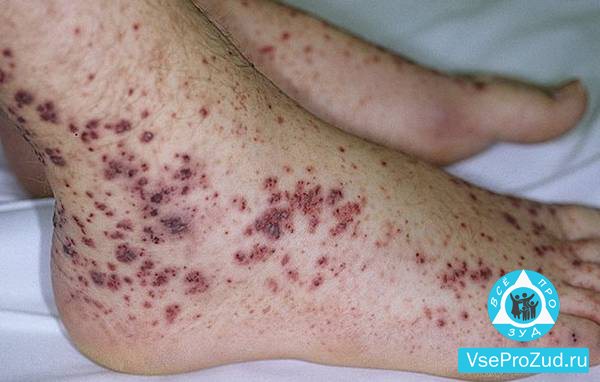
Hives
The pathological condition is a manifestation of an allergic reaction. Its occurrence is indicated if a rash in the form of pale pink blisters appears on the patient’s skin and begins to itch, resembling nettle burns in appearance. Itchy urticaria develops quickly and just as suddenly, disappears without a trace without flaking crusts after eliminating the action of the allergen.

